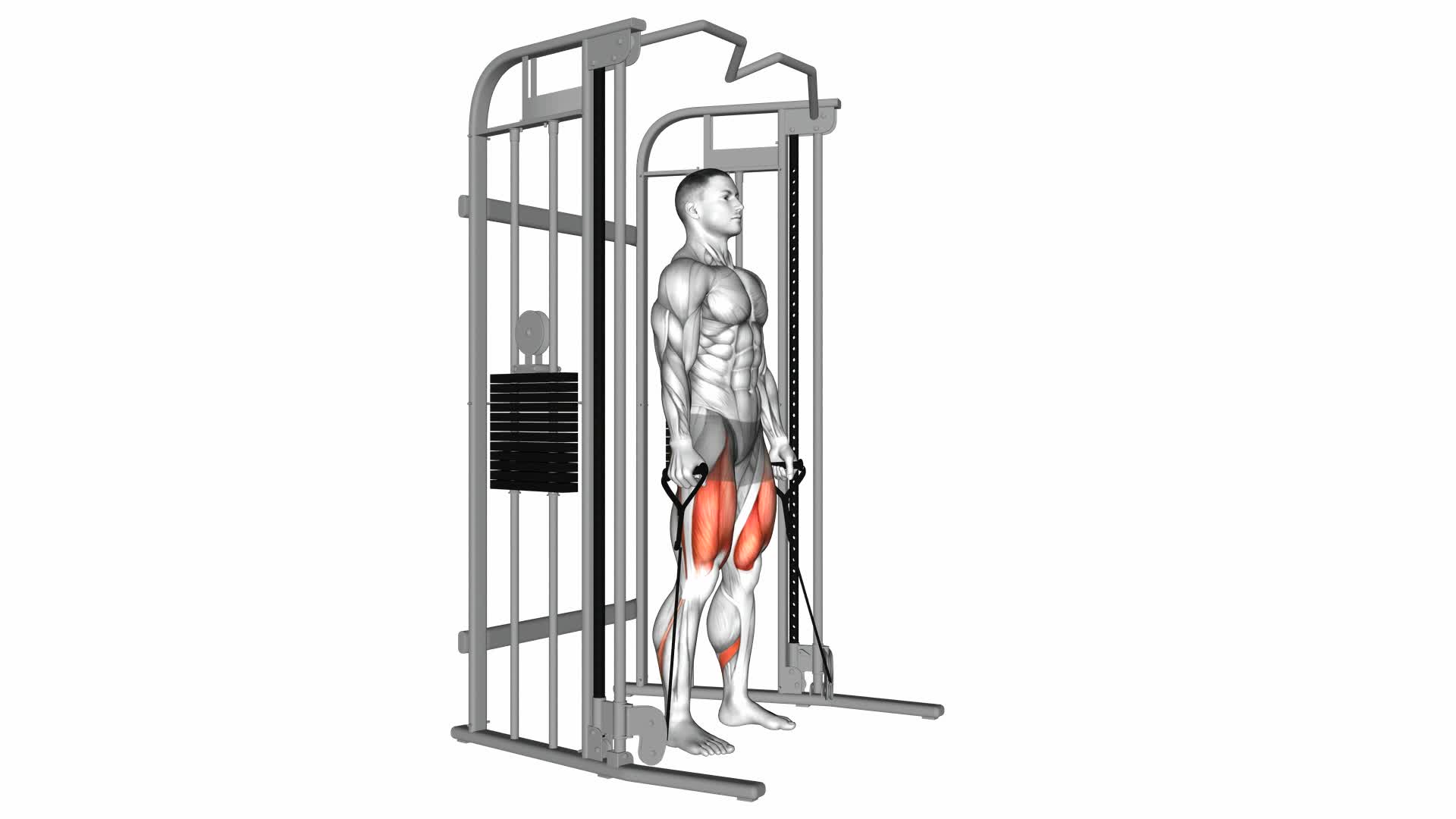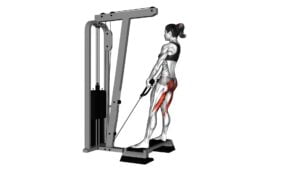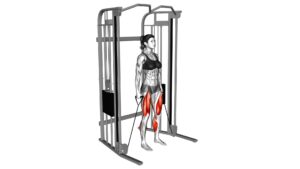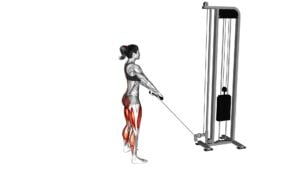Cable Deadlift – Video Exercise Guide & Tips

Looking to amp up your workout routine? Check out this video exercise guide and tips for the Cable Deadlift.
Watch This Exercise Video
You'll learn all about the benefits, proper form, and variations of this effective exercise.
Avoid common mistakes and maximize your workout with these expert tips.
Get ready to strengthen and tone your muscles with the Cable Deadlift.
Let's get started!
Key Takeaways
- Cable deadlift strengthens the entire body and activates multiple muscle groups.
- It improves muscle tone and power, promoting better posture and stability.
- Cable deadlift enhances core strength and reduces the risk of injury.
- Variations and modifications of cable deadlift can be used to target specific muscle groups and improve grip strength.
Benefits of the Cable Deadlift
To understand the benefits of the Cable Deadlift, you should know that it strengthens your entire body while providing a unique challenge to your core muscles. This exercise isn't only great for building strength, but it also offers numerous health benefits.
One of the main advantages is the activation of multiple muscle groups. When performing the Cable Deadlift, you engage your glutes, hamstrings, quadriceps, and lower back, resulting in improved muscle tone and increased power. Additionally, this exercise promotes better posture and stability by targeting the muscles that support your spine.
Another significant benefit of the Cable Deadlift is the activation of your core muscles. As you lift the weight, your abdominal muscles are engaged to stabilize your spine and maintain proper form. This not only helps to strengthen your core, but it also enhances your overall functional strength and reduces the risk of injury in everyday activities.
Transitioning into the next section about equipment and setup for the Cable Deadlift, it's important to note that in order to fully enjoy the benefits of this exercise, you'll need access to a cable machine and a bar attachment.
Equipment and Setup for the Cable Deadlift
To properly perform the Cable Deadlift, you'll need to have access to a cable machine and a bar attachment. These pieces of equipment are essential for executing the exercise correctly and safely.
When it comes to equipment options, there are a few things to consider. Firstly, make sure the cable machine you're using is in good working condition and properly maintained. This will ensure a smooth and effective workout.
Secondly, choose a bar attachment that's comfortable to grip and provides a secure hold during the exercise. It should also be able to handle the weight you plan to lift.
Lastly, setting up the cable machine correctly is crucial for a successful Cable Deadlift. Adjust the height of the cable to match your own height, ensuring that the bar attachment is at a comfortable and reachable position. Additionally, make sure the cable is securely attached to the machine to prevent any accidents or injuries.
Proper Form and Technique for the Cable Deadlift
Maintain a neutral spine and engage your core as you perform the Cable Deadlift. Proper form and technique are crucial to getting the most out of this exercise and preventing injury. Here are some tips to help you perform the Cable Deadlift correctly.
- Start by standing facing the cable machine with your feet hip-width apart.
- Grab the handles with an overhand grip, keeping your arms straight and shoulders back.
- Bend your knees slightly, hinge at your hips, and push your glutes back, keeping your chest up.
- Lower the cable handles towards the floor, maintaining tension in your hamstrings and glutes.
- Keep your spine neutral throughout the movement, avoiding any rounding or arching.
- Engage your core to stabilize your body and prevent any excessive movement.
- Exhale as you lift the handles back up to the starting position, squeezing your glutes at the top.
- Repeat for the desired number of repetitions.
Variations and Modifications of the Cable Deadlift
Now let's explore the different ways you can modify the cable deadlift to suit your needs.
First, you have various options for your stance, such as wide or narrow.
Second, you can experiment with different grip variations, like overhand or underhand.
And finally, you can adjust the weight on the cable machine to challenge yourself or accommodate your fitness level.
Stance Options
Choose from a variety of stance options to modify and vary your cable deadlift exercise. The position of your feet during the cable deadlift can have a significant impact on the muscles targeted and the overall difficulty of the exercise.
Here are three stance options to consider:
- Narrow Stance: Placing your feet close together with your toes pointing forward targets your quadriceps and inner thighs. This stance requires greater balance and stability.
- Wide Stance: Spreading your feet wider than shoulder-width apart with your toes turned out targets your glutes and outer thighs. This stance allows for a greater hip hinge and emphasizes the posterior chain muscles.
- Sumo Stance: Positioning your feet wider than shoulder-width apart with your toes slightly turned out targets your inner thighs, glutes, and hamstrings. This stance places less strain on your lower back and is great for individuals with limited hip mobility.
By choosing different foot placements, you can effectively target various muscle groups and add variety to your cable deadlift routine.
Now let's move on to the next section about grip variations.
Grip Variations
To modify and add variety to your cable deadlift exercise, you can explore different grip variations. Grip strength plays a crucial role in performing this exercise effectively.
One grip variation you can try is the pronated grip, where your palms face down towards the ground. This grip targets your back muscles more intensely.
Another option is the supinated grip, also known as the underhand grip, where your palms face up. This grip places more emphasis on your biceps.
Additionally, you can experiment with a mixed grip, where one hand is pronated and the other hand is supinated. This grip can help you lift heavier weights, as it provides a more secure hold.
By varying your hand positioning, you can challenge different muscle groups and enhance your overall grip strength.
Now, let's move on to the next section about weight adjustments.
Weight Adjustments
To optimize your cable deadlift workout, you can make various weight adjustments to challenge different muscle groups and increase the overall intensity of the exercise. Here are some weight adjustment techniques you can try:
- Increase or decrease the weight plates: By adding more weight plates, you can increase the resistance and make the exercise more challenging. Conversely, removing weight plates can decrease the resistance and allow you to focus on technique and form.
- Use resistance bands: Attaching resistance bands to the cable machine can provide an additional challenge, as they create tension throughout the movement. This can help improve muscle activation and strength.
- Implement tempo variations: By slowing down the lifting and lowering phases of the exercise, you can increase the time under tension and enhance muscle growth.
Common Mistakes to Avoid During the Cable Deadlift
Avoid the common mistakes that can occur during the cable deadlift by maintaining proper form and technique.
When performing the cable deadlift, it's important to pay attention to your form to maximize the effectiveness of the exercise and prevent injury. One common mistake is rounding your back. Keep your back straight throughout the movement, focusing on engaging your core and keeping your chest up.
Another mistake is using your arms to lift the weight instead of your legs and hips. Remember that the cable deadlift primarily targets the lower body, so make sure to initiate the movement from your hips and drive through your heels.
Additionally, avoid using too much weight that compromises your form. It's better to start with lighter weights and gradually increase as you become more comfortable with the exercise.
Lastly, rushing through the movement is a mistake to avoid. Take your time and perform the cable deadlift with controlled and deliberate movements to fully engage your muscles.
Tips for Maximizing Your Cable Deadlift Workout
To maximize your cable deadlift workout, focus on these key tips:
- Try different cable deadlift variations: Incorporating different variations of the cable deadlift into your workout routine can help target different muscle groups and prevent plateauing. Experiment with single-leg cable deadlifts, sumo cable deadlifts, or staggered stance cable deadlifts to challenge your muscles in new ways.
- Focus on muscle activation: Pay close attention to the muscles you're activating during the cable deadlift. Engage your glutes, hamstrings, and lower back by driving through your heels and squeezing your buttocks at the top of the lift. This will help you maximize your gains and build strength in the targeted areas.
- Maintain proper form: Proper form is crucial for effective cable deadlifts. Keep your back straight, chest lifted, and shoulders pulled back throughout the exercise. Avoid rounding your back or leaning forward excessively, as this can put unnecessary strain on your lower back and increase the risk of injury.
Frequently Asked Questions
How Many Sets and Repetitions Should I Do for the Cable Deadlift?
To determine the number of sets and repetitions for the cable deadlift, you need to consider various factors such as your fitness level and goals. The cable deadlift offers different variations that target specific muscle groups. It's important to start with a weight that challenges you but allows you to maintain proper form.
Gradually increase the number of sets and repetitions as you progress. Consulting with a fitness professional can help you develop a personalized workout plan.
Can the Cable Deadlift Help Improve My Squat and Deadlift Strength?
Yes, the cable deadlift can definitely help improve your squat and deadlift strength. By incorporating this exercise into your training routine, you can target specific muscle groups that are essential for both the squat and deadlift.
The cable deadlift offers variations that allow you to focus on different areas, such as the glutes, hamstrings, and lower back. By consistently practicing and progressively increasing the weight, you can see significant improvements in your squat and deadlift strength.
Is the Cable Deadlift Suitable for Beginners or Should I Have Some Prior Strength Training Experience?
The cable deadlift is a great exercise for beginners who may not have prior strength training experience. It allows you to focus on form and technique without the added pressure of heavy weights.
The benefits of the cable deadlift include improved squat and deadlift strength, as well as increased core stability and overall body strength.
It's a good alternative to the barbell deadlift, providing a different type of resistance and targeting different muscle groups.
Can I Use Different Attachments on the Cable Machine for the Deadlift Exercise?
Yes, you can definitely use different attachments on the cable machine for the deadlift exercise.
There are various variations of cable deadlift exercises that you can try, depending on the attachments you use.
Different attachments such as straight bars, rope handles, or D-handles can provide different grip options and target different muscles.
Experimenting with different attachments can help you find the variation that works best for you and adds variety to your workout routine.
Are There Any Specific Muscle Groups That the Cable Deadlift Targets More Than Others?
The cable deadlift is a great exercise for targeting specific muscle groups. When performing this exercise, you'll be focusing on your glutes, hamstrings, and lower back. These are the areas that are most activated during the movement.
Conclusion
In conclusion, the cable deadlift is a beneficial exercise for building strength and muscle in the lower body. By using a cable machine, you can target your glutes, hamstrings, and lower back effectively.
It's important to maintain proper form and technique to avoid injury and maximize results. Consider trying variations and modifications of the cable deadlift to challenge your muscles in different ways.
By avoiding common mistakes and following these tips, you can make the most out of your cable deadlift workout.

Author
Years ago, the spark of my life’s passion ignited in my mind the moment I stepped into the local gym for the first time. The inaugural bead of perspiration, the initial endeavor, the very first surge of endorphins, and a sense of pride that washed over me post-workout marked the beginning of my deep-seated interest in strength sports, fitness, and sports nutrition. This very curiosity blossomed rapidly into a profound fascination, propelling me to earn a Master’s degree in Physical Education from the Academy of Physical Education in Krakow, followed by a Sports Manager diploma from the Jagiellonian University. My journey of growth led me to gain more specialized qualifications, such as being a certified personal trainer with a focus on sports dietetics, a lifeguard, and an instructor for wellness and corrective gymnastics. Theoretical knowledge paired seamlessly with practical experience, reinforcing my belief that the transformation of individuals under my guidance was also a reflection of my personal growth. This belief holds true even today. Each day, I strive to push the boundaries and explore new realms. These realms gently elevate me to greater heights. The unique combination of passion for my field and the continuous quest for growth fuels my drive to break new ground.







